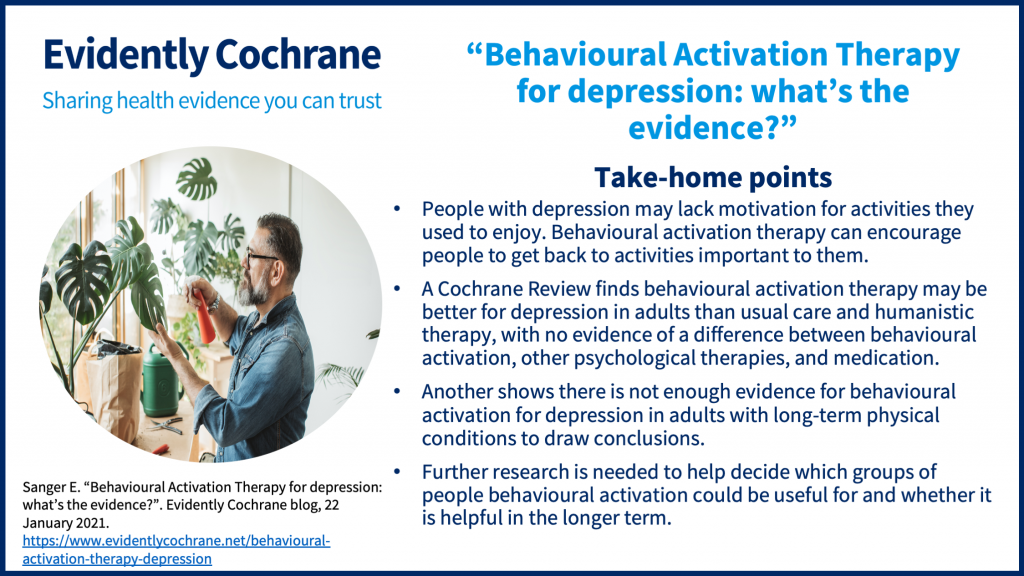In this blog for people with depression and their mental health practitioners, Emily Sanger, a Junior Doctor in York, looks at the latest Cochrane evidenceCochrane Reviews are systematic reviews. In systematic reviews we search for and summarize studies that answer a specific research question (e.g. is paracetamol effective and safe for treating back pain?). The studies are identified, assessed, and summarized by using a systematic and predefined approach. They inform recommendations for healthcare and research. from two reviews on Behavioural Activation Therapy and explores how well it works for depression in adults, with and without long-term physical conditions.
Page last checked 28 June 2023

“I felt as if I had lost myself and wouldn’t ever be the same again” . Amy’s experience of depression is common, and it can cause a persistent feeling of sadness and loss of interest in things you once found enjoyable (Uphoff et al., 2020a).
Depression can have a long-lasting effect on patients and their families, and it is common in people with long-term physical conditions. Suffering with your physical health can affect your mental health, and people with mental health problems may struggle to cope with a physical health problem (Uphoff et al., 2020b).
TreatmentSomething done with the aim of improving health or relieving suffering. For example, medicines, surgery, psychological and physical therapies, diet and exercise changes. of depression can include antidepressants and a range of psychological therapies (talking therapies), including behavioural activation (BA) and cognitive behavioural therapy (CBT).
How might Behavioural Activation Therapy help?
People with depression can become less active because of the loss of enjoyment from activities, or because they are suffering from a long-term physical condition, and this can make their mood lower. People can therefore become ‘trapped’ in a cycle of spending less time doing activities that make us feel good (Elfrey and Ziegelstein, 2009).
Behavioural activation (BA) encourages people to develop or get back into activities that are important to them. It is a type of psychological therapy which involves scheduling activities and looking at behaviours to see whether changes in behaviour can affect mood (Uphoff et al., 2020a).
You can hear more about this therapy in the video below, which introduces behavioural activation. (You can also view the transcript).
The need for evidence
Behavioural activation therapy is a treatment that may require fewer resources and less specialist training than other treatments for depression (such as CBT and interpersonal therapy), making it easier to implement in settings that have fewer specialists available including low- and middle-income countries (Uphoff et al., 2020a). While it is recommended as a treatment for depression in adults, it currently isn’t recommended for the treatment of adults with depression who also have long-term physical illness (Uphoff et al., 2020b)]. It is important to know whether this therapy is supported by evidence, what the benefits and harms might be, and how it compares to other treatments for depression.
What is the evidence?
We set out to assess the effectivenessThe ability of an intervention (for example a drug, surgery, or exercise) to produce a desired effect, such as reduce symptoms. and acceptability of behavioural activation therapy compared with other psychological therapies, medication, and ‘treatment as usual’/placebo/being on a waiting list in adults. ‘Treatment as usual’ included regular check-ups, no treatment or referral to mental health services. We did this with two Cochrane ReviewsCochrane Reviews are systematic reviews. In systematic reviews we search for and summarize studies that answer a specific research question (e.g. is paracetamol effective and safe for treating back pain?). The studies are identified, assessed, and summarized by using a systematic and predefined approach. They inform recommendations for healthcare and research. looking at the evidence in adults with and without long-term physical health conditions.
Behavioural activation therapy for adults without long-term physical health conditions
In the first review, Behavioural activation therapy for depression in adults (Uphoff et al., 2020a) we searched the evidence in January 2020 and included 53 trialsClinical trials are research studies involving people who use healthcare services. They often compare a new or different treatment with the best treatment currently available. This is to test whether the new or different treatment is safe, effective and any better than what is currently used. No matter how promising a new treatment may appear during tests in a laboratory, it must go through clinical trials before its benefits and risks can really be known. involving 14 different countries and 5495 people without long-term physical conditions.
The video below nicely summarises the findings from this review. (You can also view the transcript).
What about adults with long-term physical conditions?
The second review, Behavioural activation therapy for depression in adults with non-communicable diseases (Uphoff et al., 2020b), found only two studies to include involving 181 people, one with people recovering from a stroke (Mitchell et al., 2009), and the other involving women with breast cancer (Hopko et al, 2011). From the available evidence, it is not possible to draw conclusions about the effects of BA for this populationThe group of people being studied. Populations may be defined by any characteristics e.g. where they live, age group, certain diseases..
The need for better evidence
We have to be cautious about taking conclusions from both of these reviews because of the limited strength of evidence from studies included. Also, many of the findings from studies included in both reviews explored the effects of behavioural activation only in the short-term, so we do not know if these would continue in the longer term.
Future research could focus on high quality trials in different countries with different groups of people, including adults with long-term physical conditions without an official diagnosis of depression. This could help us determine where, and for which groups of people, behavioural activation is particularly useful.
Making decisions about treatment
People may want to consider other factors about treatment and discuss with their practitioner:
- How severe is my depression?
- Will talking therapies, medication, or a combination of both, potentially help me?
- How long do medications take to start working?
- What are the possible side-effects of different treatment options?
- How will I know the treatment is working?
- How long do different treatment options last?
- Who can I contact in an emergency? Is there a crisis team I can call if I’m in danger of harming myself?
The NHS page ‘get support from a mental health charity’ has lots of links to sources of help and information.
Join in the conversation on Twitter with @EmilySanger15 @CochraneUK or leave a comment on the blog. Please note, we cannot give medical advice and we will not publish comments that link to commercial sites or appear to endorse commercial products. We welcome diverse views and encourage discussion. However we ask that comments are respectful and reserve the right to not publish comments we consider offensive.
Emily Sanger has nothing to disclose.


